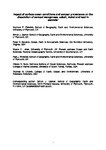Impact of surface ocean conditions and aerosol provenance on the dissolution of aerosol manganese, cobalt, nickel and lead in seawater
| dc.contributor.author | Fishwick, MP | |
| dc.contributor.author | Ussher, Simon | |
| dc.contributor.author | Sedwick, PN | |
| dc.contributor.author | Lohan, MC | |
| dc.contributor.author | Worsfold, Paul | |
| dc.contributor.author | Buck, KN | |
| dc.contributor.author | Church, TM | |
| dc.date.accessioned | 2017-12-20T18:43:23Z | |
| dc.date.issued | 2018-01-20 | |
| dc.identifier.issn | 0304-4203 | |
| dc.identifier.issn | 1872-7581 | |
| dc.identifier.uri | http://hdl.handle.net/10026.1/10450 | |
| dc.description.abstract |
© 2017. Atmospheric deposition is an important pathway by which bioactive trace metals are delivered to the surface ocean. The proportions of total aerosol trace metals that dissolve in seawater, and thus become available to biota, are not well constrained and are therefore a key uncertainty when estimating atmospheric fluxes of these elements to surface waters. The aim of this study was to elucidate the main physico-chemical controls on the dissolution of the bioactive trace metals manganese (Mn), cobalt (Co), nickel (Ni) and lead (Pb). To this end, aerosol and surface seawater samples were collected in the Sargasso Sea and subsequently used in sequential seawater leach dissolution experiments to assess the role of aerosol source, seawater temperature, pH, and concentrations of dissolved oxygen and organic ligands, on aerosol trace metal dissolution.Results reveal that changes in key physico-chemical parameters in seawater leaches had little effect on the proportions of Mn, Co, Ni and Pb released from aerosols, although organic ligand amendments impacted the size distribution of aerosol-derived Mn in solution. Conversely, aerosol source and composition had the most significant effect on the dissolution of aerosol Co and Pb, with the most 'anthropogenic' aerosol samples displaying the highest fractional solubilities in seawater (up to 58% for Co and 112% for Pb).Fractional solubilities over the range of samples and conditions tested were in the range of 50-104% for Mn, 29-58% for Co, 40-85% for Ni and 67-112% for Pb. A large proportion (36-100%, median 89%) of the total dMn, dCo, dNi and dPb was mobilised rapidly during the first leaching step (5. min), with less dTM being released in leaches 2 through 4. Furthermore, investigation of the size distribution of the aerosol-derived trace metals in seawater showed that dissolved Pb was mostly colloidal (0.02-0.4. μm), dissolved Mn and Co were mostly soluble ( < . 0.02. μm), and dissolved Ni displayed a mixed size distribution. Good empirical relationships were observed between enrichment factors for aerosol antimony (Sb) and the fractional solubilities of aerosol Fe, Co and Pb, suggesting total aerosol Sb can be useful in estimating and modelling the fractional solubility of these metals using total aerosol trace metal concentrations from historical data. | |
| dc.format.extent | 28-43 | |
| dc.language | en | |
| dc.language.iso | en | |
| dc.publisher | Elsevier | |
| dc.subject | Trace metals | |
| dc.subject | Manganese | |
| dc.subject | Iron | |
| dc.subject | Cobalt | |
| dc.subject | Nickel | |
| dc.subject | Lead | |
| dc.subject | Aerosols | |
| dc.subject | Sargasso Sea | |
| dc.subject | Fractional solubility | |
| dc.subject | Dissolution | |
| dc.subject | Global environmental change | |
| dc.subject | Anthropogenic aerosols | |
| dc.subject | Mineral dust | |
| dc.title | Impact of surface ocean conditions and aerosol provenance on the dissolution of aerosol manganese, cobalt, nickel and lead in seawater | |
| dc.type | journal-article | |
| dc.type | Journal Article | |
| plymouth.author-url | https://www.webofscience.com/api/gateway?GWVersion=2&SrcApp=PARTNER_APP&SrcAuth=LinksAMR&KeyUT=WOS:000424187700003&DestLinkType=FullRecord&DestApp=ALL_WOS&UsrCustomerID=11bb513d99f797142bcfeffcc58ea008 | |
| plymouth.volume | 198 | |
| plymouth.publication-status | In preparation | |
| plymouth.journal | Marine Chemistry | |
| dc.identifier.doi | 10.1016/j.marchem.2017.11.003 | |
| plymouth.organisational-group | /Plymouth | |
| plymouth.organisational-group | /Plymouth/Faculty of Science and Engineering | |
| plymouth.organisational-group | /Plymouth/Faculty of Science and Engineering/School of Geography, Earth and Environmental Sciences | |
| plymouth.organisational-group | /Plymouth/REF 2021 Researchers by UoA | |
| plymouth.organisational-group | /Plymouth/REF 2021 Researchers by UoA/UoA07 Earth Systems and Environmental Sciences | |
| plymouth.organisational-group | /Plymouth/Research Groups | |
| plymouth.organisational-group | /Plymouth/Research Groups/BEACh | |
| plymouth.organisational-group | /Plymouth/Research Groups/Marine Institute | |
| plymouth.organisational-group | /Plymouth/Users by role | |
| plymouth.organisational-group | /Plymouth/Users by role/Academics | |
| plymouth.organisational-group | /Plymouth/Users by role/Researchers in ResearchFish submission | |
| dcterms.dateAccepted | 2017-11-11 | |
| dc.rights.embargodate | 2019-5-13 | |
| dc.identifier.eissn | 1872-7581 | |
| dc.rights.embargoperiod | Not known | |
| rioxxterms.versionofrecord | 10.1016/j.marchem.2017.11.003 | |
| rioxxterms.licenseref.uri | http://www.rioxx.net/licenses/all-rights-reserved | |
| rioxxterms.licenseref.startdate | 2018-01-20 | |
| rioxxterms.type | Journal Article/Review |


